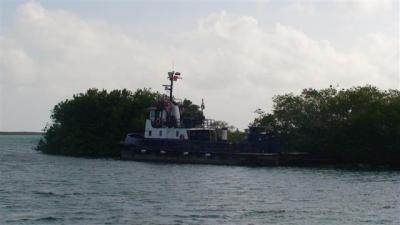Neither of us slept well. We were up with the first rays of light on the horizon and pulled up anchor shortly after the sun rose. Today’s ride was much better than yesterday’s. We were in a little more protected of an area and it made a huge difference. This morning, as Eric was walking into the kitchen, a wave came and threw him off balance. Somehow he managed to crunch his little toe against the wall. He heard his toe crack, and thinks it is broken. Sigh.
Eric also noticed the gauges didn’t seem to be working properly again. He went into the engine room and saw the connector was loose. He cleaned it and made sure it was firmly reconnected and all was good with the gauges again.
Well before Colon was visible, we could see some AIS targets on the edge of the radar screen that we knew were probably anchored around Colon. We could barely see the outlines of the ships up ahead. As we got closer, more and more targets appeared until the entire the screen was full of them. The ships went from distant outlines to intimidating masses anchored quite a way outside the bay. Eric has said at least 10 dozen times that he loves AIS. Thanks to AIS, we can tell which ships are anchored and which are moving, and if they are moving, what direction and speed they are moving at so we can stay out of their way. Fortunately, most of the ships here are anchored, and getting in looks to be fairly easy and straightforward. But not knowing if the ships were coming at us or not would have stressed us out to no end.
As the ships came into clear focus, we could vaguely see the outline of a huge industrial complex and a few skyscrapers on the shore. At 1100, Eric called port control on the radio and Continue reading →

